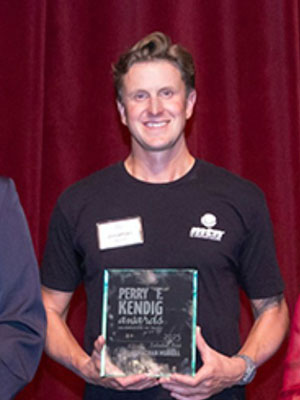Our Highlanders are using their education to do extraordinary things. In this column, we highlight some notable mentions from local, regional, national and international news media. Whether our students, alumni, faculty and staff are featured as subject matter experts in high-profile stories or simply helping make the world a better place, we’ll feature their stories.
Intern-al innovations
For college students, the trick of juggling studies, jobs, finances and professional experience opportunities has always had its challenges.

Increasingly, though, grants, student awards and innovative academic programs are helping them strike a better balance.
A Nov. 4 article on Cardinal News looked at some local students’ solutions, plus such options as the Virginia Talent + Opportunity Partnership (V-TOP), which provides funds to Virginia’s 12 public universities to support work-based learning.
Part of the story focused on Radford University, which has also taken strides “to increase work-based learning opportunities by rethinking what counts as an internship,” and where 84% of last year’s graduating class took part in at least one experiential learning opportunity.
Some university classes involve work with real-world clients, and part-time jobs on campus can occasionally be adjusted to include exposure to such factors as goal planning and project management, according to Jeanne Mekolichick, associate provost for academic affairs and a sociology professor.

Viewing the campus as a place for education within and beyond the classroom, Mekolichick said, opens up avenues for additional opportunities to prepare students for their next steps.
Cardinal also spoke with Radford senior Utibeenoabasi “Utti” Udoeyop, of Falls Church, Virginia, who has spent the past two summers in Memphis, Tennessee, as a cloud data engineering intern at the corporate headquarters for the popular parts retailer AutoZone.
Udoeyop’s position was supported by a Highlander Works Grant, which is funded through V-TOP, and went toward her travel expenses and rent during her stay.
“If I hadn’t gotten [the Highlander Works grant], I probably would not have taken the offer” from AutoZone, she told Cardinal, but said her time there was significant: “I learned so much about myself as a person.”
“Noticing the excitement”
Ordinarily, in this column, when we write about Jon Murrill, M.F.A. ’12, it’s because he’s hard at work on a public painting, like the mural he created along the Roanoke River Greenway in 2022, to name just one of many. He’s Roanoke’s official muralist-in-residence, but he’s emblazoned his brushstrokes all around the region, with large-scale artworks in Blacksburg, Salem, Stuart and other Virginia locales.

On Oct. 14, however, Murrill also became one of this year’s Perry F. Kendig Award winners, specifically its Individual Artist prize.
The Kendig awards, which take their name from Roanoke College’s seventh president and which mark their 40th anniversary this fall, are co-sponsored by Hollins University and Roanoke College, and they recognize people and groups that lend artistic support in and around the Roanoke region.
Roanoke College reported that Murrill was about to conclude a mural at a community space at the school’s Maroon Village, for which he recruited students to help and let them contribute to the effort through special spray-paint techniques. He also gave a lecture on public art at the college on Oct. 24.
“My roots are in education, so there’s a really special place in my heart for shared experiences,” Murrill said, and added of his prize: “Awards like this really mean a lot because it shows that people are noticing the excitement and encouragement we have on public art.”
A flood of memories
Nov. 4 marked the 40th anniversary of Roanoke, Virginia’s Flood of ’85, during which its river crested at a record 23.35 feet. The storm, which sprang from the remnants of Hurricane Juan, was responsible for the deaths of 10 people in the Roanoke area. About 3,000 homes and 100 businesses suffered damage, local election day procedures were thrown into chaos and the destruction cost an estimated $200 million at the time, well over half a billion dollars today.

That day’s events were recounted in a recent Cardinal News story, and in that piece, historian and author Nelson Harris ’87 recalls where he was – a Radford University student at the time, he was home visiting his parents in the Raleigh Court area.
“It was just jaw-dropping,” he said of the storm’s aftermath.
Harris would go on to serve as Roanoke’s mayor from 2004 to 2008, and during which
time would be named Radford University’s 2005 Outstanding Alumnus and begin a term
on its Board of Visitors.
In the piece, he said that while the storm was devastating, it led to civic improvements
that, otherwise, might not have happened.
Following the flood, Roanoke and the U.S. Army Corps of Engineers collaborated on a $70 million flood reduction project, which concluded in 2012.